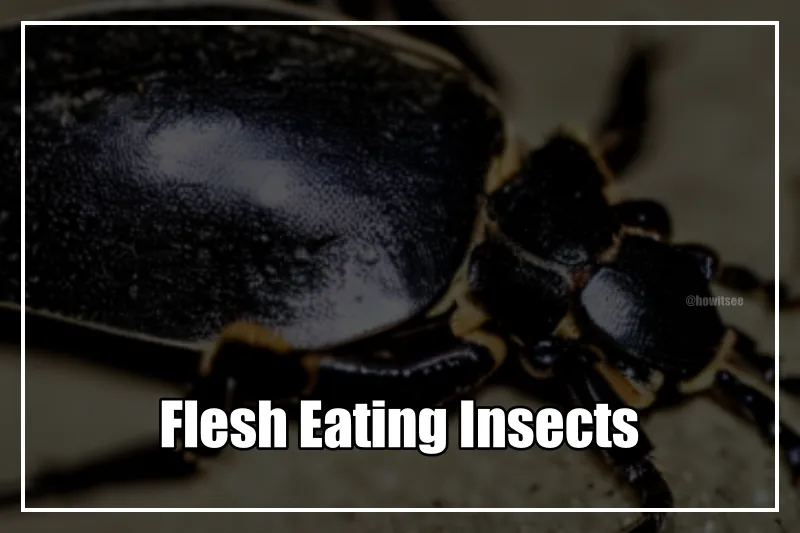In today’s article, we are going to talk about insects that eat flesh. This list also includes bugs that eat dead skin. Therefore, without further ado, let’s get going with this article, 10 Flesh-Eating Insects (Bugs that Eat Dead Skin).
10 Flesh Eating Insects
1) Varied Carpet Beetle
| Scientific Name | Anthrenus verbasci |
| Size | ~0.254cm |
| Location | across Europe |
| Color | white, brown, and dark-yellow scales |
Adult A. verbasci are between 1.7- 3.5 mm long (0.07 -0.14 in). The wing covers have an uneven pattern of white, brown, and dark yellow scales on their rounded, nearly spherical, black bodies.
Carpet beetles prefer feeding on a diet high in proteins, like animal goods like skins, furs, feathers, wool, hair, and dead insects. They feed on the dead skin cells that fall off our bodies, on the carpets, on the floor, etc.
2) Larder Beetle
| Scientific Name | Dermestes lardarius |
| Size | 8-10mm |
| Location | Worldwide distribution |
| Color | brown color with yellow mark |
The second bug on this list of Flesh eating insects is Larder Beetle. Mostadult beetles’ bodies are dark brown, measuring about 1/3 inch (8–10 mm) in length; however, the front portion of the forewings bears a wide, somewhat yellowish-grey band with dark spots.
In many parts of the world, it is a typical pest of homes and storage facilities (also known as “larders”).
It consumes animal goods, including dried meats and fish, pet food, skins and hides, and even feathers, and preserved museum exhibits like dried insects.
Larder Beetles are a pest and are known to eat away dried skins or meats, especially in the previous ages.
3) Hide Beetle
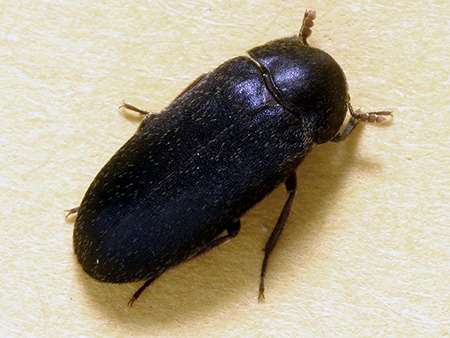
| Scientific Name | Dermestes maculatus |
| Size | 6 to 10 mm |
| Location | USA, Canada, Southeast Asia |
| Color | dark brown to black |
Hide beetles get their name from their dead, dried skins or meat product infestations. The shoulders of adult hide beetles, which measure around 13 mm (0.5 inches) long and are dark brown to black, feature pale patterns.
The little spike-like projections at the tip of the elytra are distinctive to this species. Larvae will consume high-protein foods, including dried meat, food for pets, and animal skins.
The hide beetle is typically seen as a hairy larva in the bottom of pet food bags and is frequently found on dried meat items like pet food.
4) Nicrophorus vespilloides
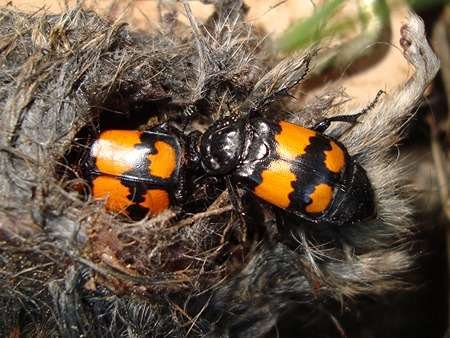
| Scientific Name | Nicrophorus vespilloides |
| Size | 10-18mm |
| Location | Alaska, North-western Canada, Northern Paleartic |
| Color | orange and black |
In the fourth position, in this list of Flesh-eating insects, or bugs that eat dead skin, we have the Nicrophorus vespilloides. They range in length from 10-18 mm. On the elytra, there are two noticeable orange-yellow bands.
Being all black, the antennae are a key identifying characteristic. The smell of carrion attracts both sexes intensely, and they will travel great distances to find it.
5) Dust mites
| Scientific Name | Dermatophagoides spp. |
| Size | 420 microns long |
| Location | Worldwide |
| Color | clear to creamy white |
Dust mites are microscopic bugs, are distant relatives of ticks and spiders, and are difficult to spot with the naked eye. The warm, humid settings are ideal for dust mites, which feed on human skin cells.
The majority of households include carpets, furniture, and bedding, which creates the perfect setting for dust mites. Dust mites aren’t parasites that sting, bite, or bury themselves in our bodies.
Instead, Dust mites are a classic example of a bug that consumes danders, which are flakes of dead skin from people
6) Chigger
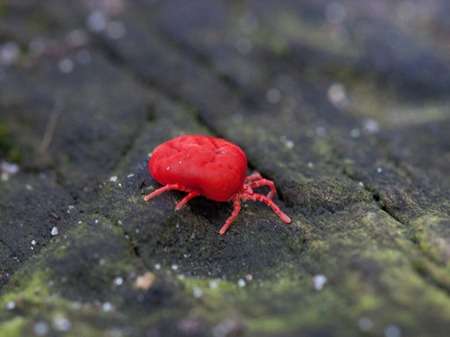
| Family | Trombiculidae |
| Size | ~0.0423418cm |
| Location | Worldwide |
| Color | clear to creamy white |
In the sixth position on this list of Flesh Eating Insects, we have Chiggers. They are the larval stage of a type of mite that is a member of the Trombiculidae family.
Itching may result when they adhere to people’s skin and feed on skin cells. Chiggers are so tiny that they are nearly invisible to the unaided eye.
We will need a magnifying lens to see them since they are so small—about 1/50 of an inch. These red mites have the appearance of tiny spiders and frequently gather in clusters on a man’s skin.
7) American carrion beetle
| Scientific Name | Necrophila americana |
| Size | 13.8-20mm |
| Location | North America |
| Color | black, tan, ivory, yellow |
Next up in this list of Bugs that eat Dead Skin, we have the American Carrion Beetle. The adults are 13.8–20 mm long, wide, and conspicuous beetles. They often have an erratic central black spot on their golden thorax.
American Carrion Beetles appear like bumblebees when in flight. The adults of this species of silphid beetle consume carrion as well as fly maggots.
8) American Burying beetle
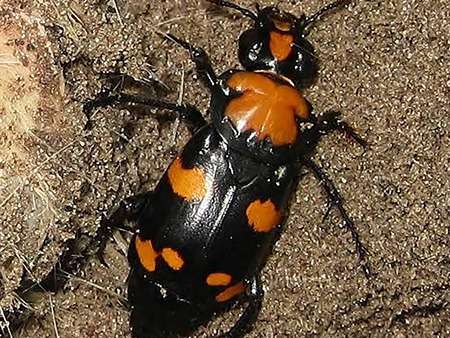
| Scientific Name | Nicrophorus americanus |
| Size | 25-35mm |
| Location | Mid-western USA, Texas |
| Color | shiny black and orange |
The American burying beetle gets its name from the habit of burying carrion (dead bodies of animals) as sustenance. To find dead flesh, the beetle uses specialized chemical detectors in its antennae.
These sensors are so sensitive that they can immediately detect the signal of faraway carcasses.
The American burying beetle, which may grow up to 1.5 inches long, is the biggest carrion beetle. They have brilliant orange-red bands on their elytra and are lustrous black body color.
9) Sea Fleas
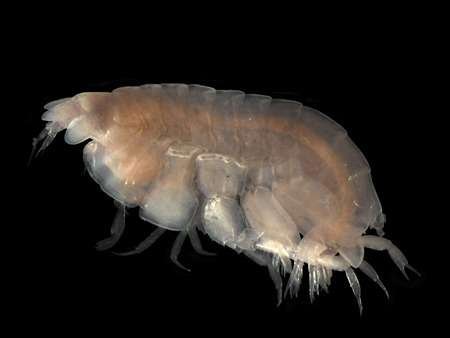
| Scientific Name | Nebalia sp |
| Size | 1-3mm |
| Location | Mid-western USA, Texas |
| Color | shiny black and orange |
Sea fleas are tiny predatory crustaceans with hundreds of identified species. They primarily eat dead marine life, including fish, crabs, seabirds, and even whales. However, if it’s handy, they will also gnaw on live human flesh.
Many need a microscope to be seen because they are so little. Sea fleas, or Lysianssid amphipods, range in size from a 1 to 3mm in length.
Sea fleas are bloodthirsty creatures that have fangs made specifically for shredding meat.
10) Black Snail Beetle
| Scientific Name | Phosphuga atrata |
| Size | up to 15mm |
| Location | Europe, Asia, Turkey |
| Color | brownish-black |
Black Snail Beetles get their name from their habit of feeding on snails. The beetle, which can grow up to 15mm in length, utilizes its long neck to reach into the shells of snails and spray them with a fluid that digests the internal tissues.
The beetle consumes carrion as well as living snails, insects, and earthworms. Older beetles are black, whereas newly molted ones are brownish.
Due to a lack of flying muscles, adults cannot fly. They release a yellow fluid when startled and pull their heads back under the shield.
Now, we come to the end of this article, 10 Flesh-Eating Insects (Bugs that Eat Dead Skin). Stay tuned for many more such interesting articles.
Also Read:

A zoology student turned writer. Nature has always been a magnet to me, and to unearth some of its secrets through my articles is my prime intention. If not engaging myself with nature and anime content, you can always find me going through some Bengali classics or filling the air with some soulful Tabla beats. An artist, trying to throw some colors to my blank canvas of life.
